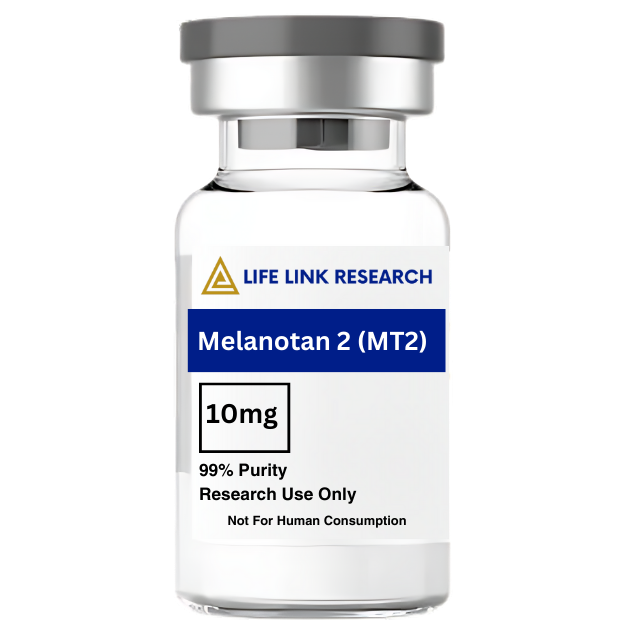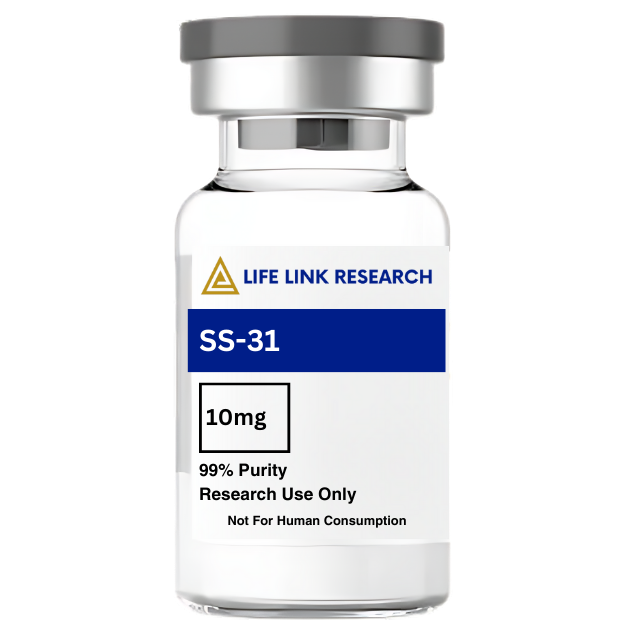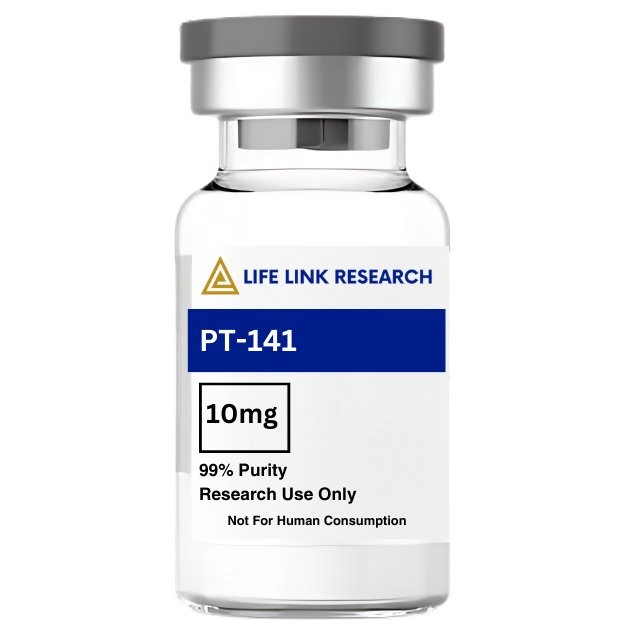Melanotan 2 (MT2) 10mg
$48.00
Out of stock
Buy 3 to Get 5% OFF
Buy 5 to Get 10% OFF
Buy 10 to Get 20% OFF
Product Usage: This PRODUCTS ARE INTENDED FOR RESEARCH CHEMICAL ONLY. This designation allows the use of research chemicals strictly for in vitro testing and laboratory experimentation only. All product information available on this website is for educational purposes only. Bodily introduction of any kind into humans or animals is strictly forbidden by law. This product should only be handled by licensed, qualified professionals. This product is not a drug, food, or cosmetic and may not be misbranded, misused, or mislabeled as a drug, food, or cosmetic.
Melanotan II is an analog of the alpha-melanocyte-stimulating hormone (α-MSH), a natural hormone involved in maintaining energy balance, stimulating melanin synthesis, and promoting sexual functions. Originally developed in the 1980s, after observing rodents administered with α-MSH began to be sexually aroused and the darkening of the skin persisted. Melanotan II is a variant of afamelanotide that produces eumelanin in the skin, which has been associated in research with boosting antioxidant activities, improving DNA repair processes, and regulating inflammation.
Peer-Reviewed Studies
Wessells, H., Levine, N., Hadley, M. E., Dorr, R., & Hruby, V. (2000). International journal of impotence research, 12(4), S74-S79.
Dorr, R. T., Lines, R., Levine, N., Brooks, C., Xiang, L., Hruby, V. J., & Hadley, M. E. (1996). Life Sciences, 58(20), 1777-1784.
Structure

Peptide Sequence: Nle-Asp(1)-His-D-Phe-Arg-Trp-Lys(1)
Molecular Formula: C50H69N15O9Molecular Weight: 1024.198 g/molPub
Chem CID: 92432CAS Number: 121062-08-6
Melanotan 2 Research
Melanotan 2 and Melanocortin Signaling
Melanotan 2 produces its effects by binding with melanocortin receptors. There are five known melanocortin receptors, each with different functions. MT-2 is known to bind primarily to MC-4R and MC-1R, but also binds weakly to MC-3R.
- MC-1R: Found on melanocytes, stimulation of MC-1R causes darkening of the skin and hair.
- MC-2R: Found in the adrenal glands, MC-2R binding promotes the secretion of adrenal hormones, such as cortisol.
- MC-3R: MC-3R is involved in appetite control and energy regulation, but little else is known about this receptor.
- MC-4R: Stimulation of MC-4R causes changes in feeding and sexual behavior. It also affects male erectile function and energy homeostasis.
- MC-5R: MC-5R is expressed on sweat glands and pancreatic islet cells.
Melanotan 2 and Autism
The newest research finding for MT-2 indicates that the peptide can reverse certain autistic features in a commonly used mouse model of autism spectrum disorder (ASD). There is no treatment for the condition, but a recent search has indicated that oxytocin therapy may be useful in mitigating some of the behavioral problems associated with ASD. Using a mouse model of maternal immune activation known to lead to autism, researchers investigated whether MT2, which is known to stimulate oxytocin release, could counteract ASD or reduce common ASD behaviors. Their research revealed that the administration of MT-2 reverses the decreased communication, impaired social interaction, and repetitive behaviors associated with autism in this particular model. In fact, the researchers found that MT-2 administration increased the expression of oxytocin receptors in specific parts of the brain, suggesting a direct correlation between oxytocin signaling in those areas and ASD-specific behaviors[1].
Melanotan 2 and Hunger
There is good evidence to suggest that MT-2 can reduce fat storage and hunger behavior in animal models. Researchers have found that the melanocortin-4 receptor (MC-4R) plays a role in food preferences and intake and that MT-2 is a potent agonist of MC-4R. Administration of MT-2 to mice causes significant reductions in how much food they consume, but also changes their preference for fatty foods. Mice given MT-2 ignore fatty foods, which they would otherwise prefer. Similarly, mice devoid of the MC-4R receptor consume fatty foods almost exclusively and are immune to the effects of MT-2[2].
The effects of MT-2 are similar to those of the hormone leptin, sometimes called the satiety hormone because it reduces cravings and food intake. Leptin, however, has never been useful in the treatment of obesity, even in individuals who are leptin-deficient. This is likely because there are two pathways for satiety, called leptin-dependent and leptin-independent pathways. Research suggests MT-2 is more effective in stimulating both pathways and thus may be a more effective exogenous treatment for reducing hunger[3],[4]. This latter finding has been bolstered by the discovery that thyrotropin-releasing hormone (TRH) gene expression, which has long been known to play a role in the leptin-satiety pathway, is also affected by MC-4R stimulation[5]. Both MT-2 and leptin are thought to cause an increase in TRH expression in the paraventricular nucleus of the hypothalamus, a region of the brain associated with satiety and food intake, but only MT-2 crosses into the central nervous system in concentrations high enough to have an effect on TRH expression.
Melanotan 2 and Diabetes
The pathogenesis of diabetes is defined by high blood sugar levels, hypersecretion of glucagon, and the production of ketone bodies[6]. It has been known for some time that leptin counteracts these factors by increasing the uptake of glucose, suppressing glucagon production, and interfering with the pathway that leads to ketone body formation. These actions do not depend on insulin and thus leptin signaling is being actively investigated as an alternative means by which diabetes might be treated.
Research has revealed that leptin’s effects on blood sugar are regulated through melanocortin receptors and that MT-2 produces similar effects[7]. This is significant because leptin has its primary effects on the brain but does not cross the blood-brain barrier as readily as MT-2. Thus, exogenously administered leptin does not reach the CNS in substantial quantities, a fact that reduces its effectiveness as a drug and hands an advantage to MT-2 even though the effects of the two peptides on melanocortin receptors are nearly identical.
Melanotan 2, Impulse Control and Alcohol Intake
In keeping with the idea that MT-2 may affect oxytocin signaling and thus behavior in ASD, research also reveals that the MC-4R receptor may play a role in impulse control. Past studies in rats have shown that administration of MT-2 reduces alcohol intake and increases water intake even in rats that prefer alcohol[8]. More recently, research has revealed that melanotan-2 works synergistically (boosting efficacy more than seven-fold) with naltrexone to blunt binge-like ethanol intake in mice [9].
Melanotan 2 and Erectile Dysfunction
Erectile dysfunction (ED) is often attributed to vascular issues and can be effectively treated in a majority of men via sildenafil (Viagra) and other drugs that improve blood flow by reducing vascular resistance. Not all ED is due to vascular issues, however, and so sildenafil and similar drugs are ineffective in a small percentage of men and in the vast majority of women who suffer from hypoactive sexual desire disorder. It has long been known that MT-2 is an effective treatment for ED, but research suggests that it may have more wide-ranging applications than drugs like sildenafil due to its actions in the central nervous system. In a study of men who had failed treatment with Viagra, eighty percent responded to MT-2 treatment[10]. MT-2 has been actively investigated in the past as a treatment for both male and female sexual desire disorders.
Future MT-2 Research
MT-2 is a heavily researched peptide, particularly regarding human behavior, sexual desire, and impulse control. The peptide, in various forms, has been investigated in clinical trials, though problems with routes of administration have forced scientists back to the drawing board. There is active and ongoing research into the benefits of this particular peptide.
MT-2 exhibits minimal to moderate side effects, low oral and excellent subcutaneous bioavailability in mice. Per kg dosage in mice does not scale to humans. MT-2 for sale at Life Link Research is limited to educational and scientific research only, not for human consumption. Only buy MT2 if you are a licensed researcher.
Article Author
The above literature was researched, edited and organized by Dr. Logan, M.D. Dr. Logan holds a doctorate degree from Case Western Reserve University School of Medicine and a B.S. in molecular biology.
Scientific Journal Author
Dr. Wessells is a UW professor, chair of the Department of Urology, and has served on several national and international professional and government committees, including the WHO International Consultations on Erectile and Sexual Dysfunction, an NIDDK working group on urological complications of diabetes, and an NIH symposium on diabetes. He is a surgeon, researcher and expert on urogenital trauma and erectile dysfunction. His clinical interests include reconstructive surgery of the genitourinary tract, acute injury management and complex surgery for male sexual dysfunction. His research interests are in urogenital trauma epidemiology and management; the physiology and pathophysiology of erectile dysfunction; reconstructive surgery; crash injury mechanics; and neurological complications of diabetes. A pro-erectile melanocortin agonist developed by Dr. Wessells and his collaborators at the University of Arizona is in clinical trials for the treatment of erectile dysfunction.
Dr. Wessells is being referenced as one of the leading scientists involved in the research and development of Melanotan 2. In no way is this doctor/scientist endorsing or advocating the purchase, sale, or use of this product for any reason. There is no affiliation or relationship, implied or otherwise, between Life Link Research and this doctor. The purpose of citing the doctor is to acknowledge, recognize, and credit the exhaustive research and development efforts conducted by the scientists studying this peptide. Dr. Wessells is listed in [11] and [12] under the referenced citations.
Referenced Citations
- E. Minakova et al., “Melanotan-II reverses autistic features in a maternal immune activation mouse model of autism,” PLoS ONE, vol. 14, no. 1, Jan. 2019.
- A. van der Klaauw et al., “Role of melanocortin signaling in the preference for dietary macronutrients in human beings,” Lancet Lond. Engl., vol. 385 Suppl 1, p. S12, Feb. 2015.
- H. Shimizu, K. Inoue, and M. Mori, “The leptin-dependent and -independent melanocortin signaling system: regulation of feeding and energy expenditure,” J. Endocrinol., vol. 193, no. 1,pp. 1–9, Apr. 2007.
- C. Bjørbaek and A. N. Hollenberg, “Leptin and melanocortin signaling in the hypothalamus,”Vitam. Horm., vol. 65, pp. 281–311, 2002.
- F. Guo, K. Bakal, Y. Minokoshi, and A. N. Hollenberg, “Leptin Signaling Targets theThyrotropin-Releasing Hormone Gene Promoter in Vivo,” Endocrinology, vol. 145, no. 5, pp.2221–2227, May 2004.
- Y. H. Lee, M.-Y. Wang, X.-X. Yu, and R. H. Unger, “Glucagon is the key factor in the development of diabetes,” Diabetologia, vol. 59, no. 7, pp. 1372–1375, 2016.
- C. Toda et al., “Distinct effects of leptin and a melanocortin receptor agonist injected into medial hypothalamic nuclei on glucose uptake in peripheral tissues,” Diabetes, vol. 58, no. 12,pp. 2757–2765, Dec. 2009.
- D. A. York, S. Boghossian, and M. Park-York, “Melanocortin activity in the amygdala influences alcohol intake,” Pharmacol. Biochem. Behav., vol. 98, no. 1, pp. 112–119, Mar. 2011.
- M. Navarro, F. Carvajal, J. M. Lerma-Cabrera, I. Cubero, M. J. Picker, and T. E. Thiele,“Evidence that Melanocortin Receptor Agonist Melanotan-II Synergistically Augments theAbility of Naltrexone to Blunt Binge-Like Ethanol Intake in Male C57BL/6J Mice,” Alcohol. Clin.Exp. Res., vol. 39, no. 8, pp. 1425–1433, Aug. 2015.
- “Synthetic melanotropic peptide initiates erections in men with psychogenic erectile dysfunction: double-blind, placebo controlled crossover study. – PubMed – NCBI.” [Online].Available: [Accessed: 15-May-2019]..
- WESSELLS, H. , HRUBY, V. J., HACKETT, J. , HAN, G. , BALSE‐SRINIVASAN, P. and VANDERAH, T. W. (2003), MT‐II Induces Penile Erection via Brain and Spinal Mechanisms. Annals of the New York Academy of Sciences, 994: 90-95.
- Wessells, H. (1998). Synthetic melanotropic peptide initiates erections in men with psychogenic erectile dysfunction: Double Blind placebo controlled crossover study. Nature.com.Available at:
- M. T. Islam et al., “Vasopressin neurons in the paraventricular hypothalamus promotes wakefulness via lateral hypothalamic orexin neurons,” Curr. Biol. CB, pp. S0960-9822(22)01121–6, Jul. 2022, doi: 10.1016/j.cub.2022.07.020.
- J. K. Y. Lau et al., “Melanocortin receptor activation alleviates amyloid pathology and glial reactivity in an Alzheimer’s disease transgenic mouse model,” Sci. Rep., vol. 11, no. 1, p.4359, Feb. 2021, doi: 10.1038/s41598-021-83932-4.
| Weight | 0.05 kg |
|---|---|
| Title | Default Title |
ALL ARTICLES AND PRODUCT INFORMATION PROVIDED ON THIS WEBSITE ARE FOR INFORMATIONAL AND EDUCATIONAL PURPOSES ONLY.
The products offered on this website are furnished for in-vitro studies only. In-vitro studies {Latin: in glass) are performed outside of the body. These products are not medicines or drugs and have not been approved by the FDA to prevent, treat or cure any medical condition, ailment or disease. Bodily introduction of any kind into humans or animals is strictly forbidden by law.




